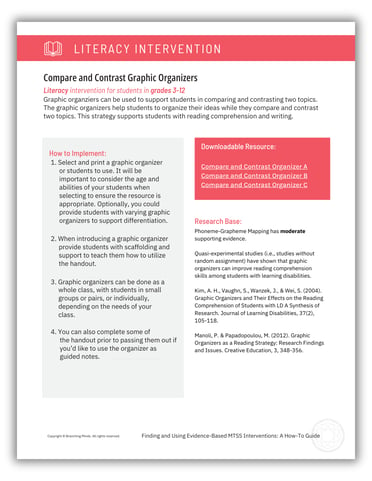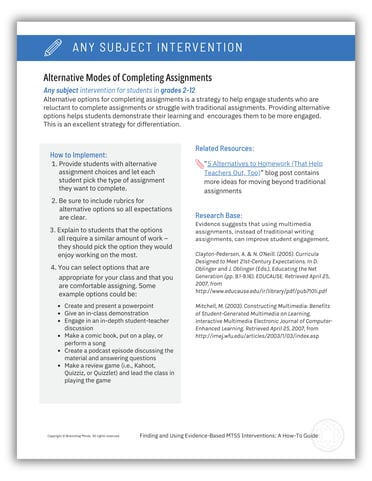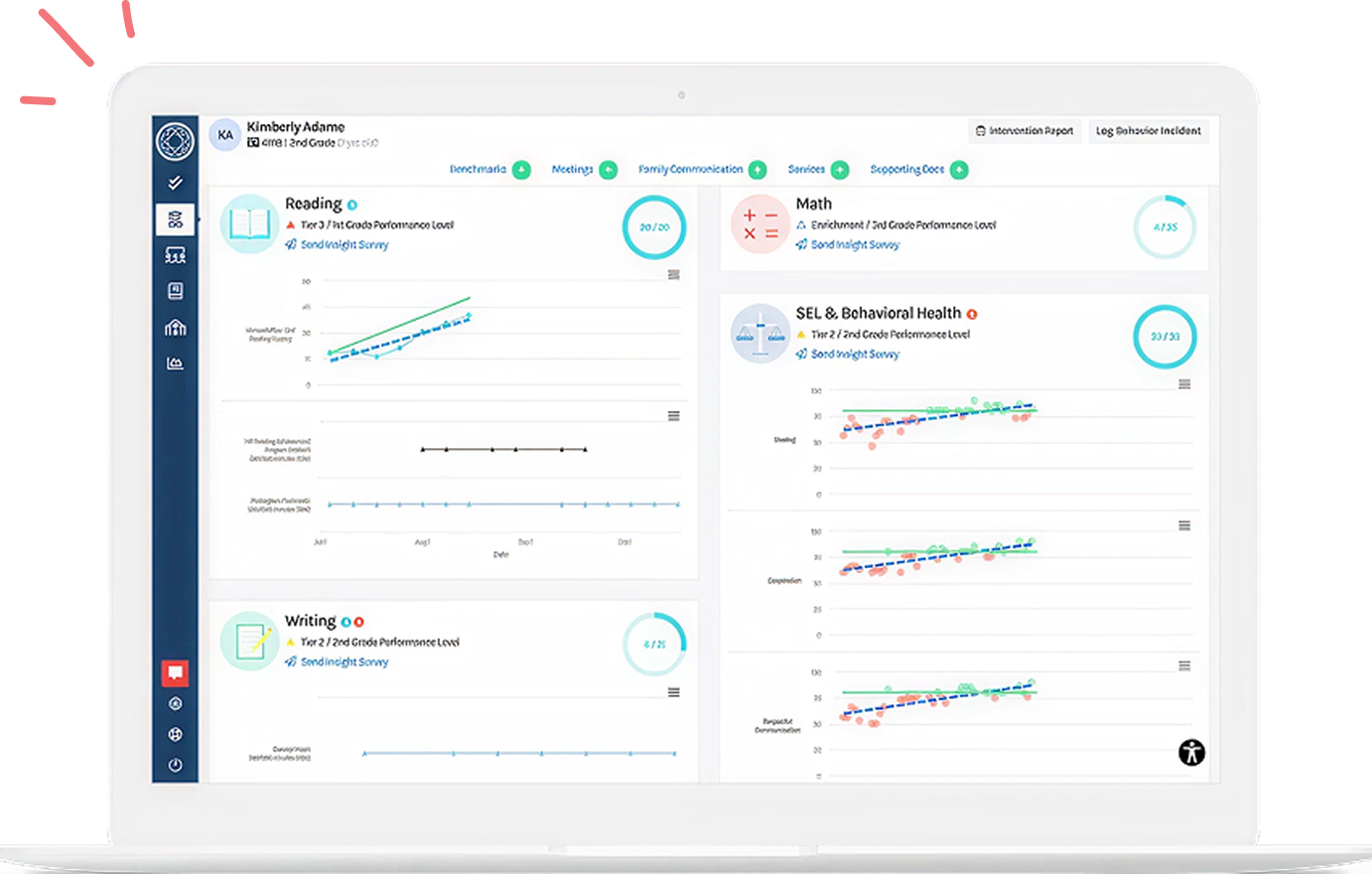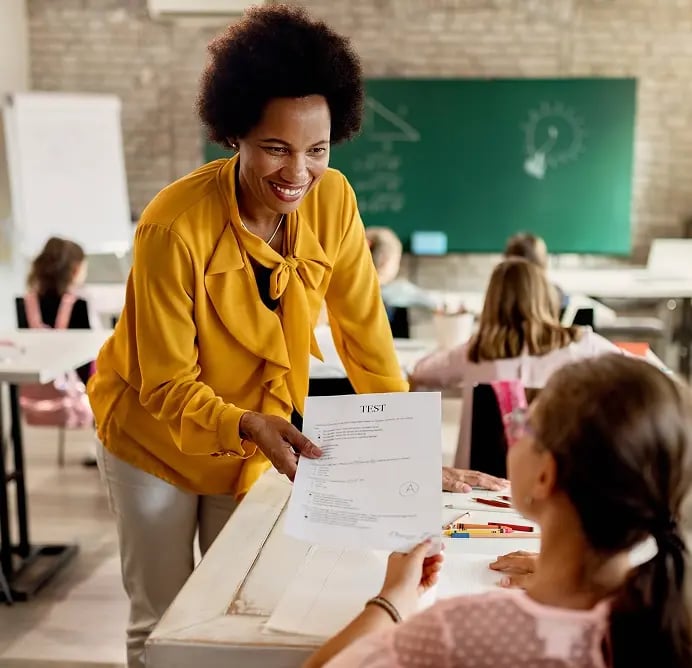The Branching Minds Support Library has hundreds of research-based supports and interventions. You can find the perfect intervention by sorting for:
-
Student Insight Survey results
-
Topic
-
Tier Level
-
Grade Level
-
School or District recommendation
AND, our Learning Sciences department evaluates each resource using
ESSA’s Tiers of Evidence. These tiers can provide districts with great insights into how interventions and supports work. Keep in mind that it’s important to review the data for the context in which an intervention or support will be utilized. An intervention program can be incredibly popular, but may not be appropriate for specific settings, grade levels, or targeted skills. After all, popularity isn’t everything!
Here are a few that could be applied to any subject or grade level:
Compare and Contrast Graphic Organizers
Literacy intervention for students in grades 3-12
⬇️ Download the PDF
Graphic organizers can be used to help students compare and contrast two topics. They help students organize their ideas while they compare and contrast, supporting students with reading comprehension and writing.
How to Implement:
Downloadable Resource:
Research Base:
Quasi-experimental studies (i.e., studies without random assignment) have shown that graphic organizers can improve reading comprehension skills among students with learning disabilities.
Kim, A. H., Vaughn, S., Wanzek, J., & Wei, S. (2004). Graphic Organizers and Their Effects on the Reading Comprehension of Students with LD A Synthesis of Research. Journal of Learning Disabilities, 37(2), 105-118.
Manoli, P. & Papadopoulou, M. (2012). Graphic Organizers as a Reading Strategy: Research Findings and Issues. Creative Education, 3, 348-356.
Alternative Modes of Completing Assignments
Any subject intervention for students in grades 2-12
⬇️ Download the PDF
Alternative options for completing assignments is a strategy to help engage students who are reluctant to complete assignments or struggle with traditional assignments. Providing alternative options helps students demonstrate their learning and encourages them to be more engaged. This is an excellent strategy for differentiation.
How to Implement:
1. Provide students with alternative assignment choices and let each student pick the type of assignment they want to complete.
2. Be sure to include rubrics for alternative options so all expectations are clear.
3. Explain to students that the options all require a similar amount of work – they should pick the option they would enjoy working on the most.
4. You can select options that are appropriate for your class and that you are comfortable assigning. Some example options could be:
- Create and present a powerpoint
- Give an in-class demonstration
- Engage in an in-depth student-teacher discussion
- Make a comic book, put on a play, or perform a song
- Create a podcast episode discussing the material and answering questions
- Make a review game (i.e., Kahoot, Quizziz, or Quizzlet) and lead the class in playing the game
Related Resources:
“5 Alternatives to Homework (That Help Teachers Out, Too)” blog post contains more ideas for moving beyond traditional assignments
Research Base:
Evidence suggests that using multimedia assignments, instead of traditional writing assignments, can improve student engagement.
Clayton-Pedersen, A. & N. O'Neill. (2005). Curricula Designed to Meet 21st-Century Expectations. In D. Oblinger and J. Oblinger (Eds.), Educating the Net Generation (pp. 9.1-9.16). EDUCAUSE. Retrieved April 25, 2007, from http://www.educause.edu/ir/library/pdf/pub7101i.pdf
Mitchell, M. (2003). Constructing Multimedia: Benefits of Student-Generated Multimedia on Learning. Interactive Multimedia Electronic Journal of Computer-Enhanced Learning. Retrieved April 25, 2007, from http://imej.wfu.edu/articles/2003/1/03/index.asp
⬇️Learn more from our intervention guide!
Find “Just Right” Interventions With the Branching Minds Intervention Library
The Branching Minds Intervention Library isn't just a list of interventions; it's a dynamic tool that helps you to identify and deliver personalized, evidence-based support. For more information about the Branching Minds library along with 15 of our most-used interventions, check out this guide Finding and Using Evidence-Based MTSS Interventions: A How-To Guide, or request a demo below.
About the author
Branching Minds
Branching Minds is a highly respected K-12 services and technology company that leverages the learning sciences and technology to help districts effectively personalize learning through enhancements to their MTSS/RTI practice. Having worked with hundreds of districts across the country, we bring deep expertise in learning sciences, data management and analysis, software design, coaching, and collaboration. Combined with our extensive toolkit of resources, PD, and technology, we provide a system-level solution. We are more than a service or a software provider, we are partners who will deliver sustainable results for educators, and a path to success for every learner.

Your MTSS Transformation Starts Here
Enhance your MTSS process—book a Branching Minds demo today








